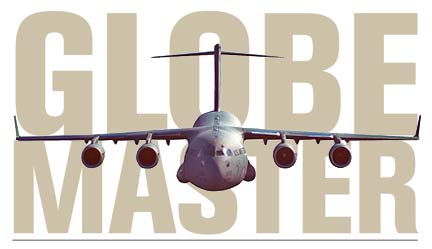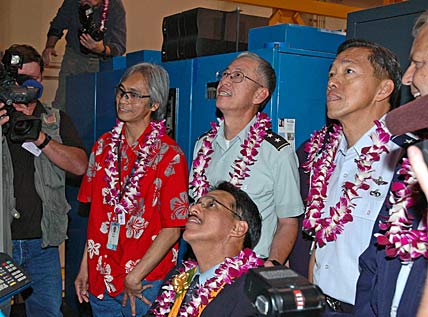

Hawaii military and civic leaders were briefed Monday at Boeing Co.'s Long Beach, Calif., assembly plant on the tons of cargo and equipment aboard a C-17 jet, like the ones that are set to be stationed at Hickam Air Force Base next year.
The Air Force's newest
cargo carrier prepares for
its first presence in Hawaii
|
The "birds" that Tanaka, 63, was referring to are the eight 174-foot C-17 jets that are bound for Hawaii, the first to be stationed outside the mainland. They will be crewed by Air Force and Hawaii Air National Guard personnel.
On Monday, more than 60 Hawaii business, government and military leaders and 100 Boeing defense workers attended a ceremony at the Boeing plant to mark the assembly of the Hawaii-bound jets.
Air Force officials say these massive airlifters will meet the growing air mobility requirements needed to move large and oversize cargo for wartime, peacekeeping or humanitarians missions.
Military and Hawaii congressional leaders have emphasized the need to station C-17s at Hickam Air Force Base to airlift soldiers, Marines and their fighting equipment quickly to potential battle areas in Asia.
Air Force officials also said the C-17s are expected to play a crucial role in future humanitarian relief efforts like the massive one after the Dec. 26 tsunami in southern Asia.
The first C-17 is expected arrive at Hickam in January, with the remaining to follow at one-month intervals. The aircraft, aircrews and mechanics will be housed at a new $190 million facility to open at Hickam in August about the same time the assembly of the first C-17 will be completed in Long Beach.

Lt. Gov. Duke Aiona and Maj. Gen. Bob Lee, state adjutant general, sat in the cockpit of a C-17 jet during Monday's rivet ceremony.
"It's a terrific airplane," said Bishop, who helps write technical manuals for Boeing. "This airplane is better that what has been built before it."
The Hickam C-17 unit, composed of members of the Air Force's 535th Airlift Squadron and the Air Guards' 204th Airlift Squadron, is part of the Pentagon's massive transformation program that places more mobile firepower in the Pacific. The program includes converting a Schofield Barracks' brigade into a Stryker brigade, designed around the Army's latest combat vehicles. The C-17s will be used to transport the Strykers to any hot spot in the world in 96 hours.
Aiona, sitting at a console and guided by Boeing worker Ron Tjan, used closed-circuit television to remotely drive the first rivet into the framework of a $202 million C-17.
Aiona was part of a Hawaii delegation that flew from Hickam on Monday morning on a Hawaii Air Guard K-C135 jet tanker and a C-47 Air Force Lear jet to California for a quick tour of the Boeing plant and to attend the ceremony. As soon as the 45-minute ceremony was over, the group boarded the two military jets for the nearly six-hour flight home.
Besides bringing tremendous airlift capabilities to the Pacific theater, Lt. Col. Scott Chestnut, vice commander of the 15th Wing at Hickam, said the C-17 squadron will "change the face of humanitarian support" and diplomatic action in the Pacific.
"When the C-17s arrive, it will be the pilot light that sparks new flames of air mobility in the Pacific," he said.
Chestnut said the C-17 can carry a payload four times greater than the C-130 propeller-driven cargo planes now flown by the Hawaii Air National Guard, going twice the distance in half the time.

Boeing Co. worker Ron Tjan, left, helped Lt. Gov. Duke Aiona place the first rivet on a C-17 cargo jet that will be stationed at Hickam Air Force Base in January. Watching the operation Monday at Boeing's Long Beach, Calif., plant were Maj. Gen. Bob Lee, middle, and Brig. Gen. Darryll Wong.
He drew a loud cheer from the defense workers and military personnel when he said he would work with Hawaii's congressional delegation to try to get Congress to approve 222 C-17s, rather than the 180 authorized so far.
Lee said Hickam's C-17 squadron could be used to transport Hawaii's Guard civil support team to anywhere in the state or the Pacific to meet the threat of nuclear, biological or chemical attacks.
The C-17's cargo bay can be configured to carry 187 litter patients or 107 passengers when outfitted with commercial airline seats, said Boeing worker Robert "Devil" Tenorio.
Despite its size, the aircraft is operated with only a crew of three -- pilot, co-pilot and loadmaster. With cargo capacity of 164,900 pounds, a C-17 is capable of airdropping a Stryker vehicle or carrying two with all of its equipment, Tenorio said. The 25th Infantry's 2nd Brigade will become the fifth of six Stryker units and will receive 310 of those vehicles by 2007.
One C-17 could also transport 144 soldiers, or airdrop 102 paratroopers and their equipment, or deliver 18 cargo pallets, or transport one M-1 Abrams tank or three M-2 Bradley armored vehicles 2,760 miles before it needs to be refueled, according to the Air Force.
In combat conditions, the crew of a C-17 begins to open the ramp of a cargo jet as soon as it hits the runway. "Within five minutes, it can offload its entire cargo," Tenorio said.
The Air Force will spend $15 million to build a short runway at the Big Island's Kona Airport to train its pilots on landing on short combat fields now being used throughout southwest Asia. The cargo jet can take off and land on runways as short as 3,000 feet and only 90 feet wide.
Lt. Col. Al Alana, a pilot with Northwest Airlines who took military leave for a year to become one of the Hawaii Air Guard's first C-17 pilots, said the aircraft is "as maneuverable as the smaller C-130, but with four times the capability."
Alana, a 1976 St. Louis School graduate, is one of 40 pilots and 60 loadmasters assigned to the Hawaii Air Guard's 204th Airlift Squadron. Fifty-five other C-17 pilots in the new squadron will come from the active Air Force. Twenty-two Hawaii Air Guard pilots are in training in Oklahoma at Altus Air Force Base.
Also attending the transitional training classes was Maj. Bob Chow Hoy, 39, who described his new jet as "a C-130 on steroids."
"It's lot more responsive," Chow Hoy said. "It's bigger, but it's fun to fly."
The four C-130 cargo planes maintained by the Hawaii Air National Guard will eventually be phased out.
C-17 Globemaster IIIThe C-17 Globemaster III can accommodate two Stryker combat vehicles, each weighing 19 tons. Here are other specifications of the aircraft:
» Function: Cargo and troop transport
The making of a squadronThe first C-17 Globemaster cargo jet squadron composed of Air Force and Hawaii Air National Guard personnel will be stationed at Hickam Air Force Base, with the first jets arriving in January.
Aug. 19, 2004: Ground-breaking of a $30 million Hickam Air Force Base C-17 Globemaster jet transport operations, training and maintenance center. Total cost: $190 million.
|
[News] [Business] [Features] [Sports] [Editorial] [Do It Electric!]
[Classified Ads] [Search] [Subscribe] [Info] [Letter to Editor]
[Feedback]

